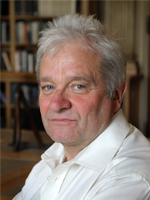Damien Hermand
Research
How a single genome can encode the blueprint of a complex organism with highly differentiated cell-and tissue-types is one of the long standing questions of Biology.
The generation of specific cell types depends on spatial and temporal regulations of gene expression. Among the three RNA polymerases, the RNA polymerase II (Pol II) is the enzyme responsible for the synthesis of messenger RNA and most small RNAs in eukaryotic cells.
Studies over decades have revealed many aspects of its subunits composition, structure and enzymatic activity.
They also revealed that many steps in gene expression initially viewed as independent are intricately coordinated in a regulated network and that the central coordinator that couples together this regulatory network is a simple tandem iterated sequence: the C-terminal domain (CTD) of the largest subunit of Pol II, Rpb1.
The CTD comprises heptad repeats of a conserved YSPTSPS consensus sequence that serves as a dynamic surface for the recruitment of proteins required for co-transcriptional mRNA processing or histone modifications.
Timely recruitment of mRNA processing factors is ordered based on modifications within the heptad. Five of the seven residues can be phosphorylated or glycosylated and the proline residues can exist in both of the cis or trans stereoisomeric states.
The resulting combinatorial complexity of the modification pattern is referred to as the CTD code, although its biological meaning is still to be explored.
Best characterized are the changes in the CTD serines phosphorylation pattern during transcription, which are both temporally and functionally coupled to the association of RNA processing complexes.
Therefore, the RNA polymerase II, rather than being the executing engine of gene transcription, functions as a central processor integrating and processing a wealth of environmental cues. In the lab, we use fission yeast to understand how modifications of the RNA polymerase II CTD are regulated during cell differentiation.
Publications
Modification of tRNA(Lys) UUU by elongator is essential for efficient translation of stress mRNAs
Fernández-Vázquez, J., Vargas-Pérez, I., Sansó, M., Buhne, K., Carmona, M., Paulo, E., Hermand, D., Rodríguez-Gabriel, M., Ayté, J., Leidel, S. & Hidalgo, E. Jul 2013 In : PLoS Genetics . 9 , 7 , p. e1003647
Gene Control during Transcription Elongation
Chávez, S., Gross, D. S., Hermand, D. & Suñé, C. 2012 In : Genetics research international . 2012 , p. 758384
Gene-specific requirement of RNA polymerase II CTD phosphorylation
Drogat, J. & Hermand, D. 2012 In : Molecular microbiology . 84 , 6 , p. 995-1004 10 p.













